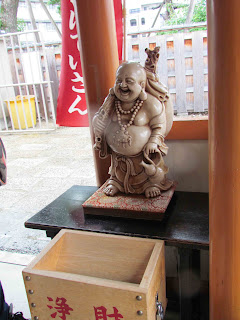And there I was, standing at the san-mon (the front gate) of the temple. I think you can see a torii (a Shinto gate equivalent to a san-mon. I walked through in succession the torii first and then the san-mon, which are the gates of two different religions. (I turned around to photograph the two gates. The temple/shrine premises is behind me in this photo.) The shrine and the temple lie on the same premises. That is, two religions coexist in the same place. The Shiten-noji is a good example of the fusion of two religions, Shintoism and Buddhism, which is now very rare. Up until the end of the Edo period, this type of religious fusion was very common. Ever since Shintoism had begun to be regarded as the "true" national religion and thus used politically, the separation of the two was promoted, often resulting in the demolishment of temples.
The central 5-storied-tower, where parts of Buddha's bones are said to be burried underneath (left) and the Shinto shrine on the east side of the temple (right).
The tower was surrounded by a square corridor which is very similar to that of cloisters in structure so that people can walk about without getting wet.
The ornament of the tower was so intricate and beautiful. Too bad it was raining and too dark to see the fine detail.
There was a painting of Buddha or one of the saints on the front wall of the tower.
There was a well by the corridor. The well is said to be protected by the dragon. The sign says,"Do not drop offerring coins into the well." It must be quite hard to retrieve them if people did.
A dragon is painted on the ceiling of the roof-like structure above the well.
If you look down into the well, you can see the reflection of the dragon on the water surface.
The actual painting of the dragon looks kind of hilarious, but the reflection appears more real and indeed scary. The sign says that if you can see the reflection of the dragon on the well water, it will drive any evil away from you. (I don't know if it is effective for lifetime.)
Quite many people stopped by the well, patted the bronze dragon and made offerrings, which are small sums of money.
Outside the temple stand a pair of warriors, called Nio. They are guarding both the temple and shrine from intruders, particularly from intruding evil spirits. The height of the Nio sculptures is about 3m.
Close-ups of the Nio.
Hotei is another popular character. He is one of the 7 gods/godess, who brings happiness.
There is a wheel like this photo at each pillar of the san-mon, which people spin and pray while it is spinning. Spinning the wheel is a substitute for giving lengthy chants and prayers. I think Tibetan Buddhism has similar spinning wheels for the same purpose.

























